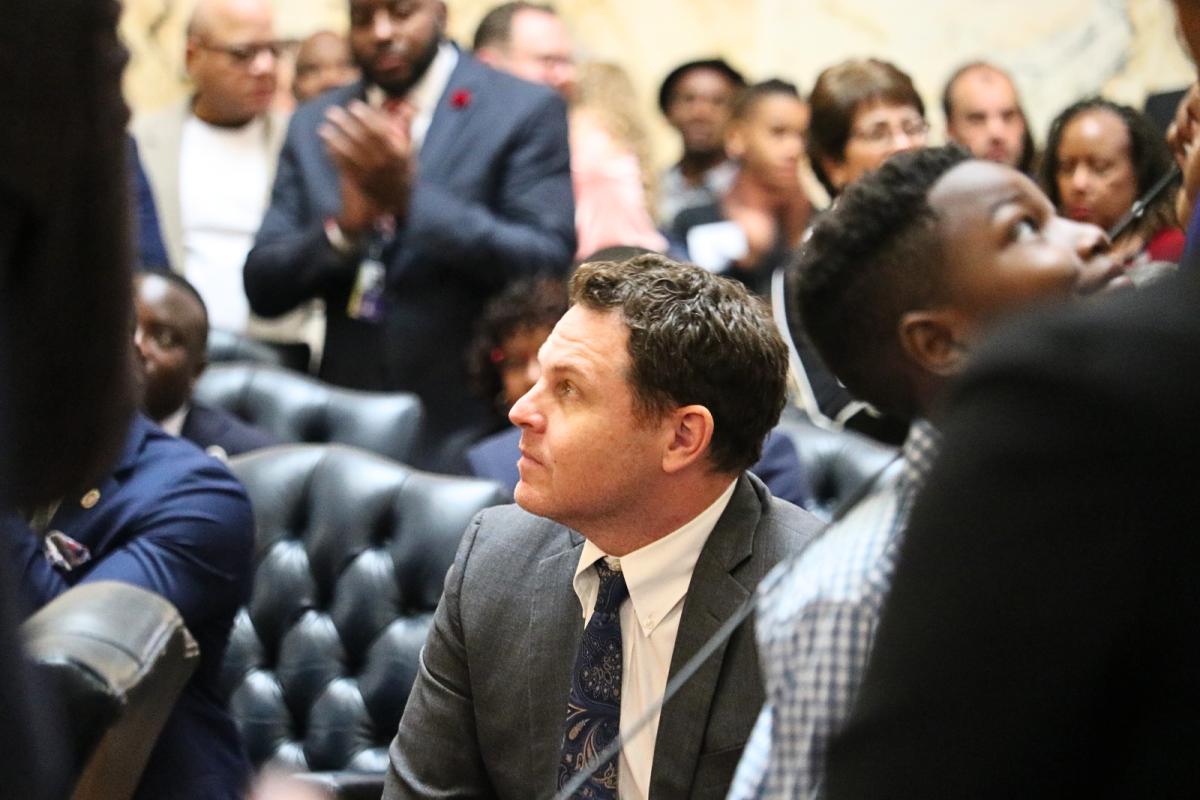
Del. Ben Barnes (D-Prince George’s and Anne Arundel) watches proceedings in the House of Delegates on the first day of the 2023 General Assembly session. Barnes is chair of the House Appropriations Committee. Photo by Danielle E. Gaines.
The Maryland House of Delegates passed a nearly $62.5 billion budget plan Friday, with nearly $1 billion in additional funding directed to state education reform efforts.
Gov. Wes Moore (D) included a $500 million payment to the Blueprint for Maryland’s Future fund on top of the required programmatic funding for the program, as well as $500 million for unspecified transportation projects.
By Danielle E. Gaines
The House version of the budget bill would shift $400 million from the transportation column and direct it to the Blueprint, for a $900 million influx.
The payments are intended to create a cushion in the education fund as the state prepares to increase public school funding by more than $3 billion annually at the end of the decade-long plan.
“One of the best things we can do to end child poverty is to make a down-payment on our Blueprint,” said House Appropriations Chair Ben Barnes (D-Prince George’s). “…I think this legislature can be proud that the commitments this legislature and this state has made to its children are being recognized and that we are going to stand by them.”
While the education fund was expected to have a $2.2 billion balance at the end of Moore’s fiscal year 2024 budget as proposed, the fund would have dipped to a near-zero balance in 2026 as state school funding obligations increased, according to earlier projections.
Overall public school funding in the amended budget proposal is $8.7 billion.
The budget plan passed by the House includes roughly $205 million in tax relief, about the same proposed by Moore earlier this year.
An anticipated $3.2 billion would be held in reserves, which is about $150 million less than the budget as proposed by Moore, but higher than limits set by the legislature’s Spending Accountability Committee.
The spending plan also includes several House priorities, including:
- $246 million for capital projects — nearly $137 million in new projects and $109 million shifted to the operating budget to free up state borrowing capacity.
- $100 million for transportation funding, about $400 million less than proposed by Moore.
- $40 million for the Cannabis Business Assistance Fund.
- $6.65 million to shift governance of the state’s beleaguered Maryland 529 college savings program to the Treasurer’s Office.
Some of the capital projects include $90 million for school construction, $25.7 million for improvements to the Baltimore City Convention Center, $25.7 million to Prince George’s County for the New Carrollton Metro project, and $18.5 million to Montgomery County for a bus rapid transit project.
Some House Republicans took issue with amendments that added $5 million to the budget to support abortion care and family planning services and $5 million in additional funding for the Maryland Office for Refugees and Asylees.
The budget now heads to the Senate for consideration, where the Budget & Taxation Committee finished work on its amendments Friday afternoon.
Early differences between the House and Senate spending plans include a $100 million difference on the Blueprint funding, which the Senate would direct to transportation projects. The Senate committee would also add $2 million that Moore and the House would have cut from the Broadening Options and Opportunities for Students Today, or BOOST, program, which provides funding for low-income students to attend private schools.
Budget & Taxation leaders are expected to present the committee’s spending plan to the chamber early next week.
Leaders in both the House and Senate characterized the differences in the budget plan as minor and expressed no doubt that the General Assembly will meet its April 3 budget deadline.



Write a Letter to the Editor on this Article
We encourage readers to offer their point of view on this article by submitting the following form. Editing is sometimes necessary and is done at the discretion of the editorial staff.